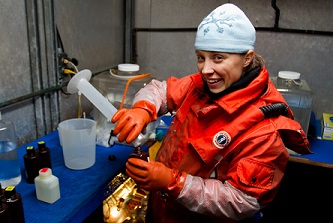
I am a research tech in the Armbrust lab which means I am fortunate to participate in many projects that the grad students and post docs are involved with. Along with caring for the lab’s phytoplankton culture collection, I am learning molecular methods, trace metal clean methods, and how to operate the lab’s flow cytometers, Influx and SeaFlow. It is a privilege to be a part of such a multifaceted group of people.
I come to the Armbrust lab with previous oceanography experience with microzooplankton. I have been a part of projects that have allowed me to gain quite a bit of sea time under my belt. The first project was Ecology and Oceanography of Harmful Algal Blooms - Pacific Northwest (ECOHAB-PNW). Here we determined growth and grazing rates of the diatom, Pseudo-nitzschia, which produces toxins and causes shellfish harvesting closures along the Washington coast. The second project was Riverine Influences on Shelf Ecosystems (RISE). The goal was to determine how the Columbia River influences the growth and grazing rates of the phytoplankton community along the Washington and Oregon coasts. The third project was the Bering Sea Ecosystem Study (BEST). For these cruises we conducted krill feeding experiments to determine feeding rates and what phytoplankton the krill are eating. All the cruises resulted in a large quantity of plankton samples and many hours with a microscope identifying and counting phytoplankton and microzooplankton.
Publications
-
H.R. Harvey, R.L. Pleuthner, E.J. Lessard, M.J. Bernhardt, and C.T. Shaw. 2012. Physical and biochemical properties of the euphausiids Thysanoessa inermis, Thysanoessa raschii, and Thysanoessa longipes in the eastern Bering Sea. Deep Sea Res II. 65-70: 173-183.
-
M.B. Olson, E.J. Lessard, C.H.J. Wong, and M.J. Bernhardt. 2006. Copepod feeding selectivity on microplankton, including the toxigenic diatoms Pseudo-nitzschia spp., in the coastal Pacific Northwest. Mar Eco Pro Ser. 326: 207-220.